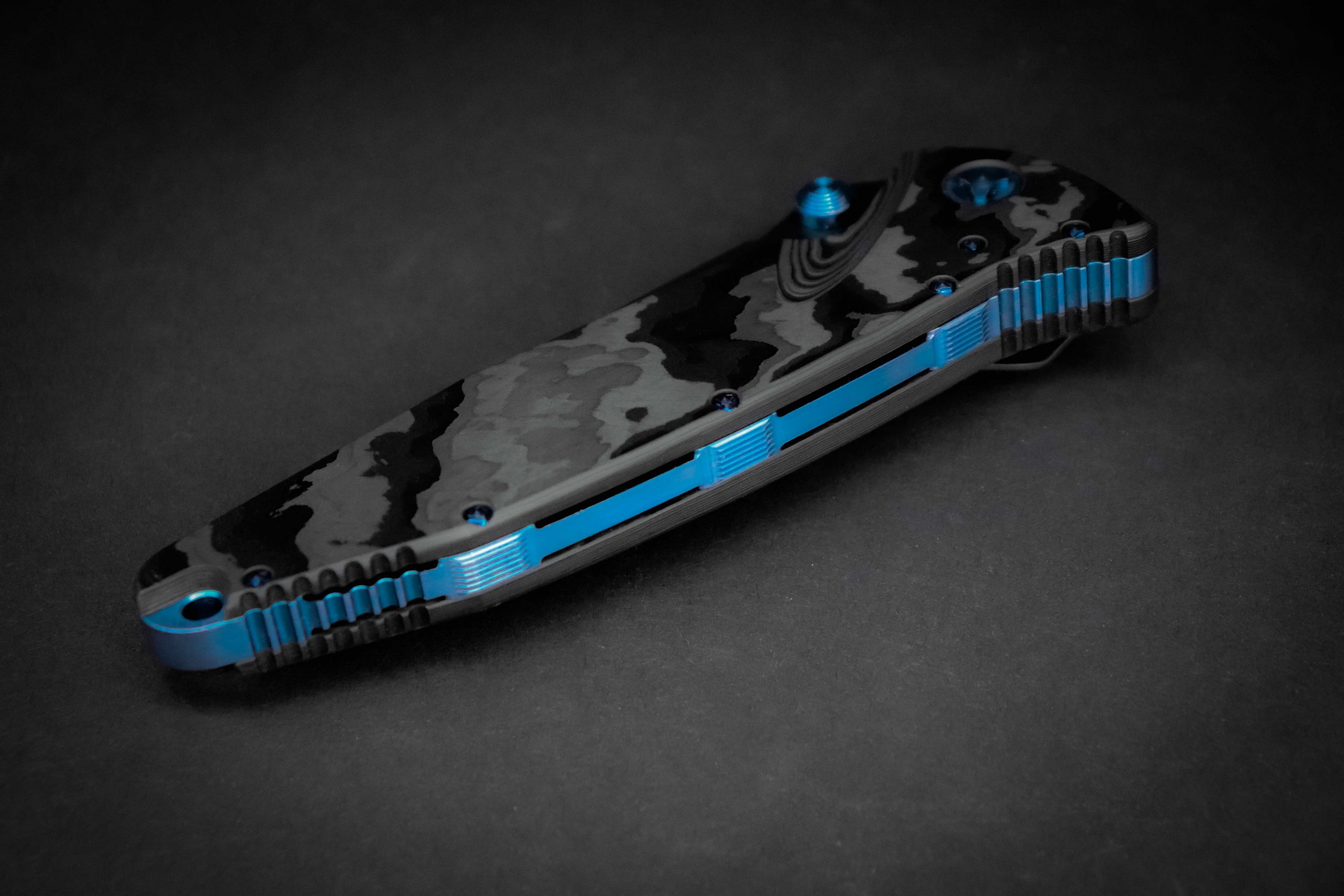When someone decides to buy a new knife, there are many factors to consider. Although choosing your perfect knife style and steel is important, finding the best knife handle material is just as important. There is a multitude of handle materials to choose from, whether it be natural materials like wood, bone, stag, or composite materials like FRN, G-10, and Carbon Fiber. Although most materials share some similar properties, every knife enthusiast has a preference for a select few properties that influence their choice. In this list, I will explain each material and its properties to inform and help you choose what material you might want on your next knife.
- G-10 is a high-pressure fiberglass laminate created by stacking multiple layers of glass cloth, soaking it in epoxy resin, and compressing it under heat until the epoxy cures. It is similar to carbon fiber and Micarta but with glass cloth as a filler material. This handle material has high strength and low moisture absorption while providing a high electrical insulation level and chemical resistance. These properties offer a variety of uses, such as first being used in printed circuit boards, and due to it being easy to customize, G-10 has become a staple in knife and gun handles.
- Richlite is made from resin-infused sheets of paper, making it incredibly durable and highly versatile. Initially created over 70 years ago for industrial tooling and pattern making, Richlite has expanded into a premium surface material used in many fields. Due to Richlite being handmade from layers of high-quality, custom-crafted paper, the surface texture found on the material comes from the natural variation in the way the fibers are laid on the paper.
- Carbon Fiber is made of woven strands of carbon that offer high stiffness, tensile strength, temperature tolerance, and chemical resistance, as well as a high weight-to-strength ratio and thermal expansion. The type of carbon fiber typically used in knife handles is a composite style of handle material made from layers of woven carbon permeated with plastic resin and baked to form a carbon-fiber-reinforced polymer.
- Micarta is a popular brand of composites varying from linen, canvas, paper, fiberglass, and more. In the knife world, Micarta is well known for its layered canvas used as a popular handle material, formed from soaking linen cloth in phenolic resin and layering it to make a lightweight, strong, and very stylish handle material. Micarta is made out of natural linen, it comes in a variety of colors and can also be textured either smooth or rough, making it very versatile.
- G-Carta is a newer material to hit the market and is made from a combination of natural fibers and fabrics mixed with epoxy under pressure and heat. As I’m sure you could tell from the name, this handle material is a hybrid of G-10 and Micarta, sharing similar features with each.
- FRN stands for Fiberglass Reinforced Nylon, a high-strength thermoplastic material that offers resistance to abrasion and bending. (this material is also referred to as GFN, Zytel, Grivory Zy-Ex, and Griv-Ex, typically depending on what company produces it.) FRN is one of the more affordable options for knife handle materials, but because of its low price tag, many people view it as the “cheap” option. Even so, it offers a strong material that fairs well against normal wear and tear and harder use tasks.
- Resin is not the strongest material, nor is it the grippiest, which usually leads to it being used for aesthetics. The resin used in knife handles is a synthetic material that is often used to seal a specific pattern or even a tiny object into the handle. This material isn’t used as often but can be found on many display knives and collector’s items.
- C-TEK is a resin-infused handle that has an aluminum honeycomb suspended inside of it. It has the same properties as resin, just with an added flair of style with the aluminum held within it.
- Titanium is widely recognized for its high strength-to-weight ratio and offers a low density that makes it quite ductile and gives it a relatively high melting point. Titanium is used in high-end knives to reduce weight and increase strength and customizability since it is easily anodized to a variety of colors.
- Aluminum is one of the various metals used in knife handles, usually in folding knives. Aluminum is often used for its strength and lightweight nature, as well as its low cost. It can also be milled very easily, which many companies take advantage of in order to make unique grip patterns and sometimes even 3D contours.
- Stainless Steel is a material you would typically find on less expensive knives or any number of fixed blades. It often adds quite a bit of weight, so it isn’t often used in high-end knives, but it still offers a considerable amount of strength. It can often be used in single-piece construction fixed blades, but the stainless steel used is just a continuation of the blade steel used as a handle, so there can be some variation to its properties.
- Brass is another heavier metal used in knife handles. This material is typically used either on knife bolsters and guards or on special editions of other popular knives. It’s well known for its ability to patina with continual use, leading to an aged look that looks amazing. You can also polish it to keep it looking pristine if you’d prefer a clean look.
- Copper is a well-known material that shares some similarities with brass. The main difference is that copper weighs more and can form a patina faster. The patina can also develop a green tint after some time, which can be manipulated for a unique finish.
- Bronze is another well-known material similar to Brass and Copper, but with a different color and patina. While brass is made from copper and zinc, bronze is made from copper and tin.
- Zirconium is popular on custom and high-end knives. It was originally intended for use in military use and nuclear power stations but quickly rose to popularity among many hobbyists and knifemakers alike for its appearance. If treated and polished correctly, Zirconium produces a lustrous gray, almost black, glass-like-finish. It’s easy to machine, but the dust produced is extremely hazardous, making the process very tedious and expensive.
- Ti-Mascus is another high-end and expensive knife handle material created by master smiths specifically for use in knifemaking. They used a variety of titanium alloys that anodize at different rates to give it a Damascus appearance with a unique flair of color. Since Timascus is made as a combination of different grades of titanium, it also holds the same properties.
- Mokume is similar to Damascus and Timascus but is made with softer precious metals. You can typically see the use of Gold, Silver, and sometimes even Iron, Bronze, and Brass. This knife handle material has a longer history than some of the other high-end metals, going as far back as the 17th century. It gets its name from the Japanese phrase “Mokume-gane,” which means eye or wood grain metal. Mokume is often used in jewelry and other fine arts-related products.
- Damascus has an extensive history originating from Damascus, Syria. The legend says that the first Damascus knife could bend 90 degrees and come back to true, as well as cut a feather in half as it floats in the air. The Damascus we use today is an imitation of what was made then; where “true” Damascus has a pattern inherent to the material, modern Damascus is created by taking different steels and forge welding them and then dipping them in acid to show the final pattern. It shares the same properties as steel, as it is essentially the same material.
- Bone is one of the more sought-after natural materials found in both fixed blades and folding knives. Bone has been used in knife handles for thousands of years. It is seen as a premium handle material and can be used in either its natural shape or carved into a different shape. Bone offers high durability and resistance to regular wear and tear while being fairly customizable. You can easily sand the bone into whatever shape you’d like as well as engrave it just as easily as you would on wood.
- Stag is another form of bone, normally referring to the more natural version that you would get from staghorn. This handle material is often found in traditional folding knives and some fixed blades. It offers the same properties as bone.
- Mammoth Molar is one of the more exotic knife handle materials on this list and is sourced from woolly mammoth fossils. This handle material is typically tens of thousands of years old and has a beautiful layered structure that is both stylish and durable. Mammoth Molar is typically treated with resin and can be dyed to create different color combinations. Because of the ancient nature of this material, you may not see it as often in production knives, but it is used heavily in custom and high-end knives.
- Wood is the most varied knife handle material on this list. It comes in a variety of different colors and styles. It can either be in a natural wood form, or a compressed, more durable version of wood. It offers decent durability in most use but is more susceptible to humid or wet environments since it can easily absorb water unless it is coated or sealed. Wood can also be carved into intricate patterns or grip styles. You can typically find wood like Birch, Maple, Cocobolo, Hickory, Ironwood, and more.
- Stabilized Wood is another relatively new knife handle material that is made by being infused with resin through a combination of pressure and vacuum cycles and then cured. This makes the wood harder, denser, stronger, and more water-resistant. Since it is stabilized with resin, it typically has a higher sheen.
- Abalone is a common name for a mollusk that is highly sought after for its shell, as it has a very unique and beautiful pattern. This knife handle material is most often used in high-end custom knives for an added bit of flair. Although it isn’t the strongest material, it is one of the most beautiful and will hold up to everyday use.
- Mother of Pearl is another knife handle material you can get from a Mollusk and has an iridescent sheen that reflects light to make a beautiful handle material. Much like Abalone, it is not a very strong material but will hold up with everyday use.
- Leather is often used for fixed blade knives like the famous Ka-Bar series of fighting/utility knives. Typically stacked, leather handles are popular for demanding knives and tools. It is easy to use in hot or cold environments, although they can degrade over time, as long as you take care of them, they can last for decades. Leather stacked handles also offer a more unique style, with the leather being able to mature over time to a darker look and a more rigid feel, and an overall more comfortable grip as it adjusts to your hand.
- Kirinite is an acrylic material that has strands of poly paper woven into it. This knife handle material is fairly easy to work with, making it lower in cost, while also having a unique look and high polish-ability that many knifemakers love to use. It’s fairly durable and hard, but since it is just another acrylic it can be brittle and feel a little plasticky.


